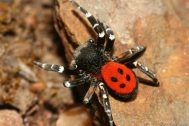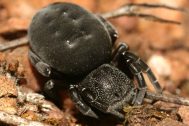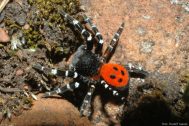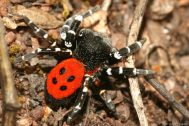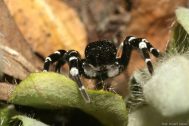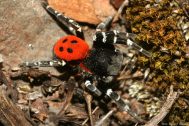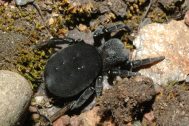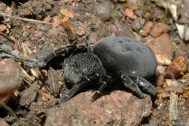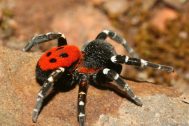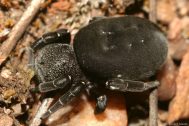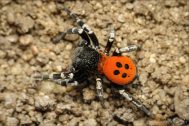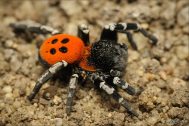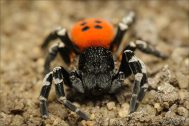| Nálezy podle období | |||||
|---|---|---|---|---|---|
| Eresidae | 0-1900 | 1901-1950 | 1951-2000 | 2001+ | ∑ |
| Eresus sandaliatus (Martini & Goeze, 1778) Kriticky ohrožený | 8× | 7× | 15× | ||
Eresus sandaliatus (Martini & Goeze, 1778)
| České jméno | stepník černonohý |
|---|---|
| Stupeň ohrožení | Kriticky ohrožený |
| Nálezy | 15 nálezů, 5 kvadrátů |
| První nález |
1959, J. Buchar, Řezáč in litt. |
| Poslední nález | 2022 , Šimon Petrov |
| Areál rozšíření | European - ME [Boh.] |
| Fytogeografická oblast |
|
| Původnost stanovišť |
|
| Vlhkost stanovišť |
|
| Stratum |
|
| Osvětlení stanovišť |
|
| Hojnost výskytu |
|
| Nadm. výška | 350-600 |
Literatura
Stepník černonohý na Manětínsku
Stepníci patří mezi velmi zajímavé druhy pavoučí fauny a to jak kvůli svému vzhledu, tak i vzácnosti (až na stepníka rudého jsou všichni řazeni mezi kriticky ohrožené druhy). Dá se dokonce říct, že jsou ikonou některých stepních lokalit na území České republiky. Jejich dobrým identifikačním znakem je u samců zářivě zbarvený zadeček se čtyřmi černými puntíky – to je příležitost k jednoznačnému určení i pro laiky. Samice je sice větší (až do 1,5 cm), má ale pouze jednolité černé zbarvení.Habitat selection by threatened burrowing spiders (Araneae: Atypidae, Eresidae) of central Europe: evidence base for conservation management.
Habitat selection in sedentary, long-lived burrowing spiders is a key life-history event that directly affects their reproductive success. In this study, we analyzed the role of the chemical and physical properties of soil in habitat selection by threatened temperate burrowing spiders. We examined 296 burrows of three Atypus spp. and three Eresus spp. at 68 sites in Czechia. We found that the study species were associated with soils that have high or very high cation exchange capacity, which allows the presence of a stable nd humid microclimate in their burrows. We found that specific bedrock types can be used as predictors of the presence of particular study species. All Eresus spp. avoided compacted soils. However, when present in soils with very low penetration resistance, they were limited to sites with high soil cohesion. The burrows of all study species were located at well-drained sites. The study species seemed to be selective for a steppe-like character of their microhabitat but not necessarily for its southward orientation. We found the study species even at sites where steppes were present in the early 1950s and that underwent later afforestation but not extensive landscaping or plowing. What types of disturbances can be sustained by the study species and how long it takes the decreased populations to recover after, e.g., trampling associated with grazing, remain to be investigated.
Zajímavý nález Eresus sandaliatus Martini et Goetze, 1778 z Černockého vrchu u Malé Černoce na Podbořansku (severozápadní Čechy).
Eresus sandaliatus je vzácný druh pavouka z čeledi stepníkovitých (Eresidae), jenž je řazen mezi kriticky ohrožené druhy (CR) naší arachnofauny (Ř EZÁČ et al. 2015). Během floristického průzkumu Podbořanska v průběhu května 2015 jsme učinili zajímavý nález samce tohoto stepníka na Černockém vrchu u Malé Černoce. Tento taxon dosud nebyl ze sledovaného území znám.
Taxonomic review and phylogenetic analysis of central European Eresus species (Araneae: Eresidae)
Ladybird spiders (Eresus spp.) have attracted scientific interest since the 18th century, but taxonomical knowledge of the genus is unsatisfactory. Early classification based on colour and size variation divided European Eresus into numerous species. These were later lumped into one predominant morphospecies, Eresus niger/E. cinnaberinus, which could be found from Portugal to Central Asia. Here, we perform a major revision of Eresus from northern and central Europe using morphological, phenological, habitat, distribution and molecular data. Three species, Eresus kollari, Eresus sandaliatus and Eresus moravicus sp. n. were distinguished. The name E. niger (originally Aranea nigra) cannot be used as the name A. nigra was used for a previous spider species. The name E. cinnaberinus is considered a nomen dubium. The three species differ in size, colour pattern, shape of prosoma and copulatory organs, phenology, and have slightly different habitat requirements. No morphologically intermediate forms were recorded. In contrast to distinct morphology and phenology, the genus is genetically complex. Genetically, the mitochondrial haplotypes of Eresus sandaliatus and Eresus moravicus sp. n. are monophyletic, whereas those of Eresus kollari are paraphyletic. Eastern central European Eresus kollari is likely a hybrid lineage between Eresus sandaliatus and the monophyletic western central European Eresus kollari. Because eastern and western European Eresus kollari are morphologically and phenologically indistinguishable, we did not formally split them. However, detailed population-based research in the future may partition Eresus kollari into additional species.
Fotografie
Statistiky
Dle měsíce v roce
Dle nadmořské výšky
Dle metody sběru (15 použitých nálezů)
| Eresus sandaliatus (Martini & Goeze, 1778) CR | Samci | Samice | Mláďata | Nálezy |
|---|---|---|---|---|
| Neurčeno | 5 | 3 | 1 | 7 |
| Individuální sběr | 13 | 2 | 0 | 7 |
| Zemní past | 3 | 0 | 0 | 1 |
| Samci | Samice | Mláďata | Nálezy |
Dle biotopu (15 použitých nálezů)
| Eresus sandaliatus (Martini & Goeze, 1778) CR | Samci | Samice | Mláďata | Nálezy |
|---|---|---|---|---|
| Travnaté stepi | 3 | 1 | 0 | 2 |
| Neurčeno | 8 | 2 | 1 | 9 |
| Skalní stepi na jiných horninách | 1 | 2 | 0 | 2 |
| Lesostepní doubravy | 9 | 0 | 0 | 2 |
| Samci | Samice | Mláďata | Nálezy |




